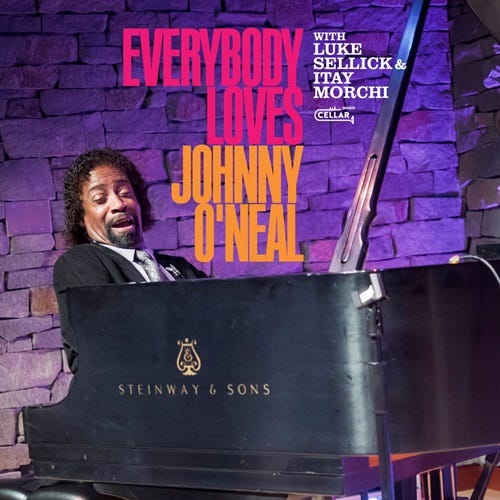Johnny O'Neal - Everybody Loves Johnny O'Neal
(Cellar Music, 2025)
“I initially planned to start these notes by stating that much has been written about the enigmatic, mysterious, and quirky Johnny O’Neal. However, as I reflected on those words, a contrary thought struck me:not nearly enough has been written…”
—Cory Weeds, Liner Notes, Everybody Loves Johnny O'Neal
The music industry is easy to get into if one is not counting on being the next Taylor Swift. Getting name recognition is the challenge and in a field where (judging by the deluge of material constantly being released) every dentist can be a jazz singer and every church music minister with a guitar can play the blues. This phenomenon depresses the signal-to-noise ratio to such a point that, for the music enthusiast, it takes a great effort to find the diamond among common crystals. An endorsement like that of Mr. Weeds on behalf of Mr. O’Neal serves as a spotlight on otherwise criminally neglected talent.
What Johnny O’Neal is…is a supremely talented entertainer. He has the instrumental and vocal chops out of the wazoo, but also one intangible for entertainment, a huge, sunny personality, like a bear hug with a smile and wink. The proof lies in the opening tune, Fred Fisher’s 1922 “Chicago (That Toddin’ Town).” O’Neal begins big with a Latin-ribbed blues introduction reminiscent of the smiling blues only the late Gene Harris1 was capable of. O’Neal vocalizes happily like a Klonopin-addled Bob Wills urging on his Texas Playboys had had Wills been Black and his band urban.
O’Neal’s singing voice is authentic. Not perfect, but authentic. He croons “Love Letters” while playing his best Errol Garner. It is obvious that O’Neal loves performing and his audience returns the love. This is so hip it hurts. Then, O’Neal detonates into nothing short of a psychotic break. Launching into Lovin’ Sam F. Heard’s “Home Boy Blues,” O’Neal hits a chord,
“Home Boy, I can see your ass is drunk again
Well, Home Boy, Home Boy, Home Boy, Home Boy, I can see your ass is drunk again
You have been them drinking, them doubles, doubles, doubles, doubles…
Everywhere we have been.”
O’Neal sings with unbridled gusto, backed only by bassist Luke Sellick and drummer Itay Morehi, for two choruses, returning to the piano, channelling the great Gene Harris and causing an entire population rejoicing that Harris has returned (in spirit). O’Neal doesn’t worry about going off the mic. He is having too good a time, transferring that good time to his to his audience.
O’Neal plays the closest thing to a standard in the mashup “Come Sunday/Did I Ever Really Live” His piano playing can be tender or ragged as the song requires; his singing as precise or reckless and the mood informs. The uptight will label O’Neal as crude and unprofessional, his performances well short of perfect. But there is no honesty in a perfect performance or one that is otherwise well behaved and “proper.”
What Johnny O’Neal is … is honest. And he is out to provide his audiences an honestly good time. He is an exceptional pianist and unique vocalist whose art shines brightly.
Gene Harris (1933–2000) was an American jazz pianist known for his warm sound and blues and gospel infused style that became known as soul jazz. Between 1956 to 1970, he played in The Three Sounds trio with bassist Andy Simpkins and drummer Bill Dowdy, recording for Blue Note and Verve Records. He enjoyed a comeback courtesy of bassist Ray Brown, recording notable albums for Concord Jazz.




After reading your review I'm going to listen to him straight away !
Find that album he cut for Concord.